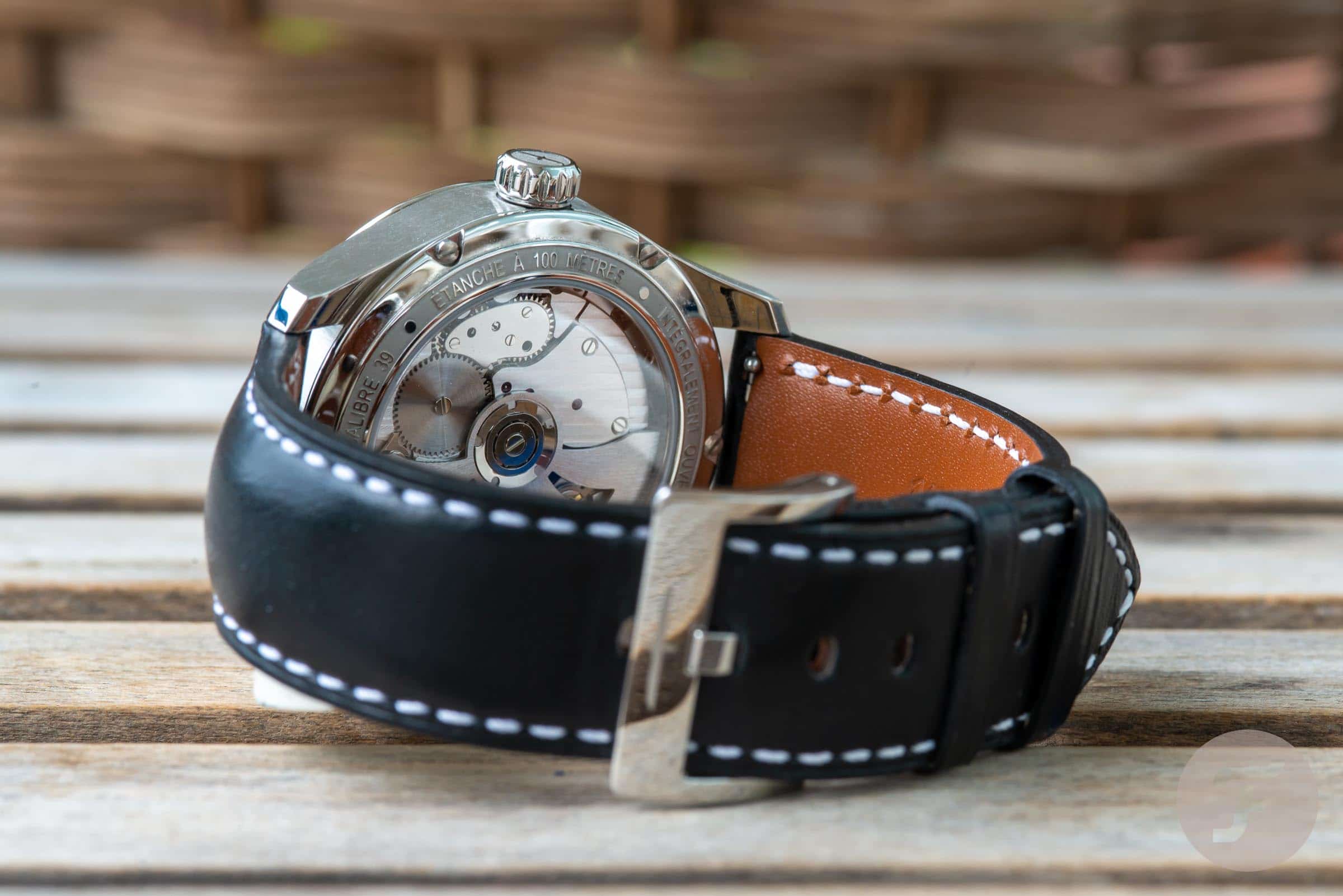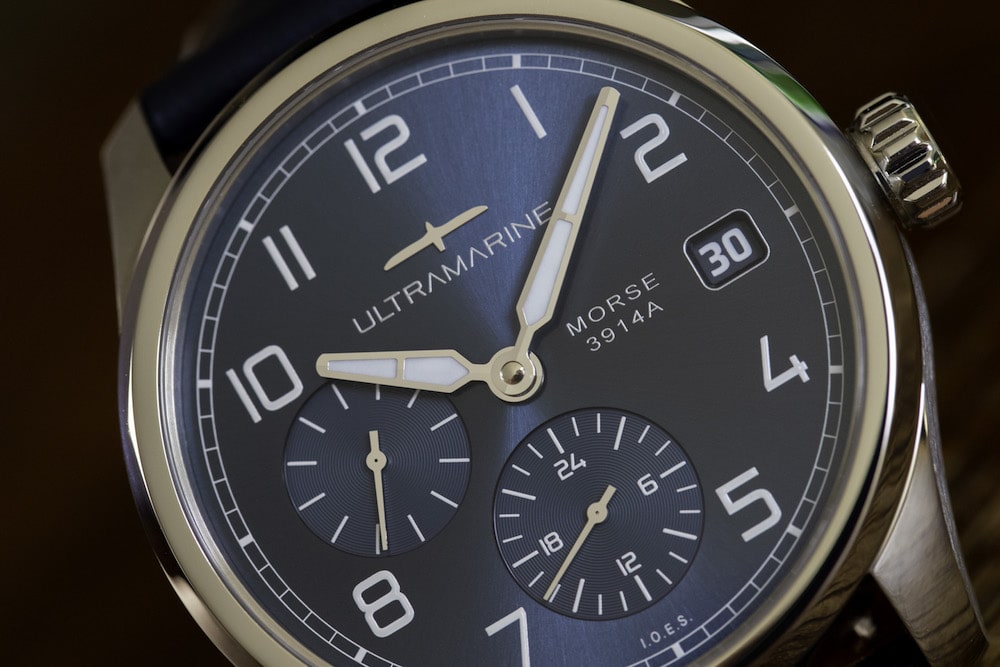Hands-On Review: Ultramarine Morse GMT 3914A
We all know meanwhile that many Swiss Made labeled watches are not entirely made in Switzerland. The ‘Swiss Made’ label is protected by Swiss law since 1971, and its requirements several times strengthened since. Even the last enhanced requirements, dating from January 1st, 2017, do not specify that a watch has to be entirely made in Switzerland.
Ultramarine Morse GMT 3914A is I.O.E.S.
Currently, the most important criteria for a watch to be considered ‘Swiss Made’ under Swiss law, are the following:
- its movement is Swiss(*)
- its movement is cased up in Switzerland
- the manufacturer carries out the final inspection in Switzerland
And then, (*) a movement is considered Swiss if:
- it has been assembled in Switzerland
- it has been inspected by the manufacturer in Switzerland
As well:
- the components of Swiss manufacture (of the watch in total, without the strap and buckle) account for at least 60% of the total value, without taking into account the cost of assembly.
These by far are not the only regulations to comply with to meet the Swiss Made criteria. As well, it’s challenging to determine which costs and values we’re talking about. Production costs of parts, or the selling/buying price of these parts, in the case of a company buying them to build watches.
If you’re interested in reading and learning all ins and outs in this matter, I would suggest you study the official document the FHS (Swiss Watch Federation) provides. Guide for the designation ‘Swiss’ for watches.
Swiss Made
So let’s go on and produce an imaginary situation here. We’ll build a high-end balance wheel, hairspring, and escapement entirely in Switzerland. The rest of the movement, bridges, wheels, bearings, etc., will be produced in a country far far away. The chances are that the cost of the balance wheel and escapement are over 60% of the components of the entire watch. Specifically, if the other components come from low-cost countries, and now that even research, development and certification costs add up to the Swiss value as well.
Assembling the movement, from its Swiss Made balance and escapement and overseas made other components, in Switzerland, and testing it in Switzerland, makes it match the Swiss Made criteria. Then casing it in Switzerland (even if in a foreign-produced watch case) and carrying out the final inspection in Switzerland as well, legally makes it an official Swiss Made watch.
…truly Swiss Made? Not really.
But do we feel that this is truly a Swiss Made watch? A watch from which most of its components, except for the balance wheel and escapement, are produced elsewhere than in Switzerland. Not really.
I.O.E.S. – Intégralement Ouvré En Suisse
And that’s what annoyed Lionel Bruneau, founder, and designer of Ultramarine Watches, as well. He wants his French wine to be produced in France, and his Gouda cheese to be made in The Netherlands. So Lionel wants a Swiss Made watch to be produced in Switzerland as well. And that’s why he came up with a watch which is I.O.E.S. – Intégralement Ouvré En Suisse, or translated, Entirely Manufactured in Switzerland.
… I.O.E.S. Entirely Manufactured in Switzerland
So Lionel Bruneau investigated if it would be possible to produce an entire watch, with only Swiss components, in Switzerland. And it was. Every single part of the Ultramarine Morse GMT 3914A, up to the tiniest screw or gasket, is made in Switzerland. And to make this unambiguously clear the designation I.O.E.S. This meant that, for Ultramarine watches, no ETA or Sellita movements could be used, as it is not precisely clear if all parts and components of these movements are produced in Switzerland. So, let’s look at the Ultramarine Morse GMT watch
Eterna movement
Ultramarine choose to use the Eterna caliber 3914A caliber instead. A modern (28.800/h 29 jewels) movement entirely made in Switzerland with only the use of Swiss components. Besides this, it has the advantage of over 65 hours of power reserve over regular GMT movements like the 2824/SW200 or 2892/SW300 from ETA/Sellita, which stick around 40 hours.
…by using this movement the watch would be legally Swiss already
The cost of this movement alone would have been over 60% of the costs if the rest of the watch would have been produced outside Switzerland. The movement alone would have been enough Swiss value to buy all the rest of the components outside Switzerland, and still, have the watch legally qualified as a Swiss Made watch. With the case, dial, hands, glasses, strap, and buckle made in China, for instance, the moment would have been at more than 80% Swiss value. But even if it legally is, for Lionel Bruneau that’s not a Swiss watch.
Swiss Made should be 100% made in Switzerland
According to Lionel, Swiss Made should be entirely made in Switzerland. He sees it as a matter of honesty. In his opinion, if it says ‘Swiss Made’ it should be ‘Swiss Made’ and not ‘Shenzhen Made’. Currently, in this price league – below CHF 2.000,= – this often is the case for cases, dials, hands, glasses, straps, and buckles.
So for Ultramarine, to the screws, only 100% Swiss parts manufacturers were chosen. Ultramarine cases are made at Bouille in Neuchâtel. The dials at Fehr in La Chaux-de-Fonds. Hands are made, piece per piece in Haute Horlogerie quality, at GMG in Le Locle. Sapphire glasses at AB Saphir in Courgenay. Last but not least, Creation Perrin Suisse in La Chaux-de-Fonds produces the hand-sewn leather straps, while buckles are made by Cornu, also in La Chaux-de-Fonds. Finally, the watches are assembled by MTK2.0 in Bulle, which company also takes care of the after-sales service.
So far about the origin
How about the watch itself? Does the watch benefit from being entirely made in Switzerland? Let me say it like this, it sure shows.
…does the watch benefit?
The quality of finish is inevitable. Visually present by the surfaces of the casing, the level of finish of the dial, and certainly the hands. I tried to get this visual in the pictures as well; I hope it shows, it’s difficult to catch two-dimensional, however. It’s a feeling as well; one feels that the product in your hands is something above average. The knowledge that the entire watch has been produced by highly skilled Swiss manufacturers helps as well, of course.
Anything negative about the watch?
Not really. The things which come to mind are more personal preferences, rather than design or quality flaws. It might seem that the watch is quite thick. In fact, with only 12mm of height, it isn’t. The shape of the case probably makes it look like.
Then I found it rather difficult to exactly synchronize the little GMT hand with the regular time hands. It often seems to be a minute or 10 off. Normally one would turn the crown against the direction of setting to avoid the hand-play. With the Eterna caliber 3914A that’s not possible because the other direction of the crown will set the date. So that needs a little of getting used to it and set the little second timezone hand slightly earlier than the regular time. Setting at exactly noon (or 00:00) hour helps alignment as well.
This two-sided rotation of the crown for different functions brings as well that one has to remember which direction to rotate the crown, to either change the second time zone time or to change the date. Clockwise will change the 2nd time-zone, while counter-clockwise will change the date. It would have been nice if there was an indication on the watch to remember this.
Conclusion
Ultramarine wants to offer watches which are entirely made in Switzerland at a fair price point. With the Ultramarine Morse GMT, it has succeeded in that. It’s an honest watch at an honest price. Additionally, Ultramarine will donate 10% of its profits to Non Governmental Organisations committed to marine protection and conservation as well.
The Ultramarine Morse GMT currently is available in a black – like the one we had for review – and blue dial version. More information on Ultramarine and its watches, as well as the possibility to order them, can be found on their website www.ultramarine-watches.com
Specifications of this watch follow here:













